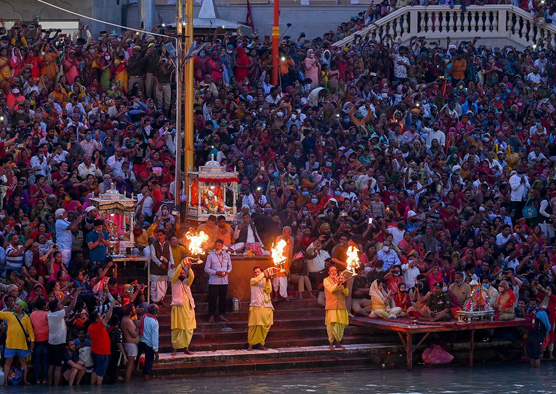About Kumbh Mela
What is Kumbh Mela?

Kumbh Mela in Hinduism is the largest gathering of people for a pilgrims bathe in the world. It is celebrated four times every 12 years, the site of the observance rotating between four pilgrimage places on four sacred rivers: at Haridwar on the Ganges River, at Ujjain on the Shipra, at Nasik on the Godavari, and at Allahabad at the confluence of the Ganges, Yamuna, and the mythical River Sarasvati. It is also celebrated every 6 years in Haridwar and Allahabad which is known as 'Ardh Kumbh'.
History of Kumbh
In the ancient legend tells that the gods were cursed by the sage 'Durvas' and began to lose their power. They turned to Brahma (the creator god) and Vishnu (the preserver) for help. On their advice the gods made a pact with the demons; in return for their assistance in attaining the nectar (Amrit) of immortality, they agreed to share it with them. The demons met their side of the bargain and churned the primordial ocean in order to release the nectar (Amrit) which the gods collected in a pitcher. However, the gods, then fought for the nectar and a divine carrier flew away with the pitcher. The Demons chased them for 12 days (which is equivalent to 12 years in Human Life). During the chase some of the nectar falls into four places which is Haridwar, Allahabad, Nashik and Ujjan. The places where the nectar fell to earth are the four locations where the Kumbh Mela is celebrated today.

Major Attractions in Kumbh Mela
A key feature of the Kumbh Mela is the attendance of Sadhus, or holy men.
There are several different sects that show their devotion in different ways:
• Nagas do not wear any clothes and cover their bodies with ash
• Urdhwavahurs put their bodies through severe hardship
• Parivajakas have taken an oath of silence and use bells to alert others to their presence
• Kalpvasis bathe three times a day at very specific times
• Shirashasins stand for 24 hours and meditate while standing on their heads
They travel to the Kumbh Mela to make themselves available to pilgrims, allowing them to take 'darshan' or respectful visual exchange, a concept of receiving divine power by being in the presence of the holy men
• In Kumbh you can see "Akhara" which is a place where the Sadhus(Holy Men) carry out their practices and is also meeting place for religious group. These saints are said to be followers of Lord Shiva and Vishnu, hence there are Shaivite Akharas (dedicated to Shiva) and there are Vaishnavite Akharas (dedicated to Vishnu).
• Satsangs are a very important part of the Kumbh Mela. Devotees sit for hours and listen to the Sadhus who preach. During the mela there are a lot of ashrams and halls where people can offer prayers. One can go and sit inside if they want to hear what the priests have to say about Hinduism and spiritualism as these saints have a good knowledge of religion.

Places to Visit in Allahabad.
Hanuman Temple- Close to the Sangam in Allahabad, this Hanuman Temple is unique in North India, for its supine image of Lord Hanuman. Here the big idol of Lord Hanuman appears out in a reclining posture. When the River Ganga gets in spate, this temple emerges submerged.
Anand Bhavan- Anand Bhavan is the former residence of Nehru family which has now been transformed into a museum showcasing various artefacts and articles of the era of Independence movement in India.
All Saints Cathedral- Built in the late 19th century, All Saints Cathedral is a spectacular Anglican Christian Church in Allahabad. Constructed in the gothic style architecture, the church boasts of intricately carved glass panels and marble altars.
Chandrashekhar Azad Park- Originally known as Alfred Park during the British colonial era or Company Garden. It is renamed after freedom fighter Chandra Shekhar Azad, who sacrificed his life here, during the Indian independence struggle in 1931, the park has his statue. it is a public park of 133 acres area and is the biggest park
New Yamuna Bridge- is a cable-stayed bridge over the river Yamuna Running over 1510 metres, the bridge is supported by cables to its deck.
Allahabad Fort- Allahabad Fort is a splendid work of architecture that was built during the reign of Akbar, the Mughal Emperor of Allahabad in 1583. The marvellous structure is located on the banks of the confluence of the Rivers Ganga and Yamuna and Saraswati
Ashoka Pillar- Placed outside the Allahabad Fort, this 16th century structure was constructed by Emperor Akbar. The exterior of the Ashoka Pillar has inscriptions from Ashoka in the Brahmi script. Even Samudragupta and Jahangir have added some inscriptions later in the Gupta script, a refined version of Brahmi.
Khusro Bagh- It is a large walled mughal garden surrounding the mausoleums of Khusrau Mirza(died 1622), eldest son of emperor Jahangir, Shah Begum, Khusrau's mother (died 1604), a Rajput princess and Jahangir's first wife, and that of Princess Sultan Nithar Begam (died c.1624), Khusrau's sister.[12] It presents an exquisite example of Mughal architecture.

